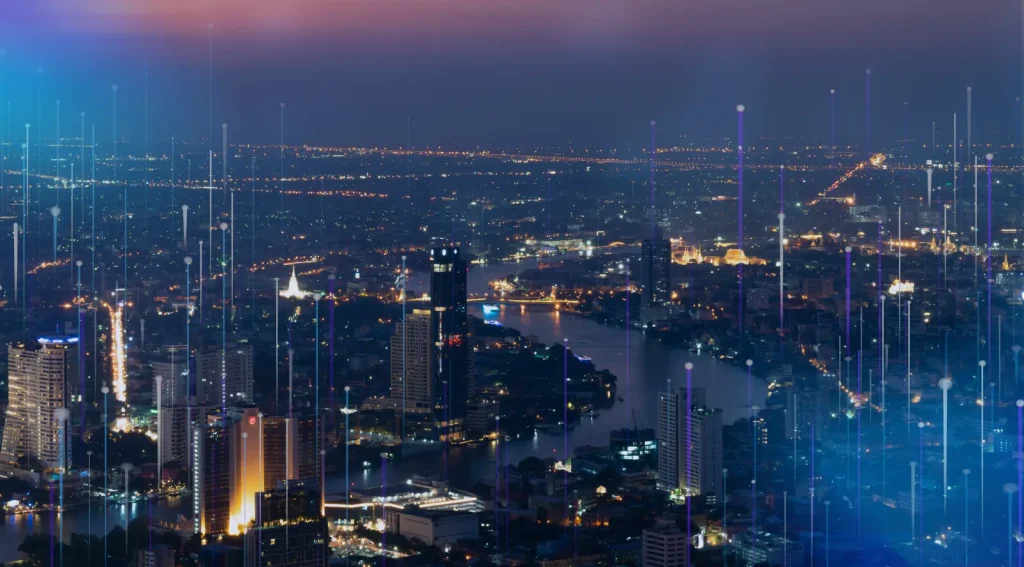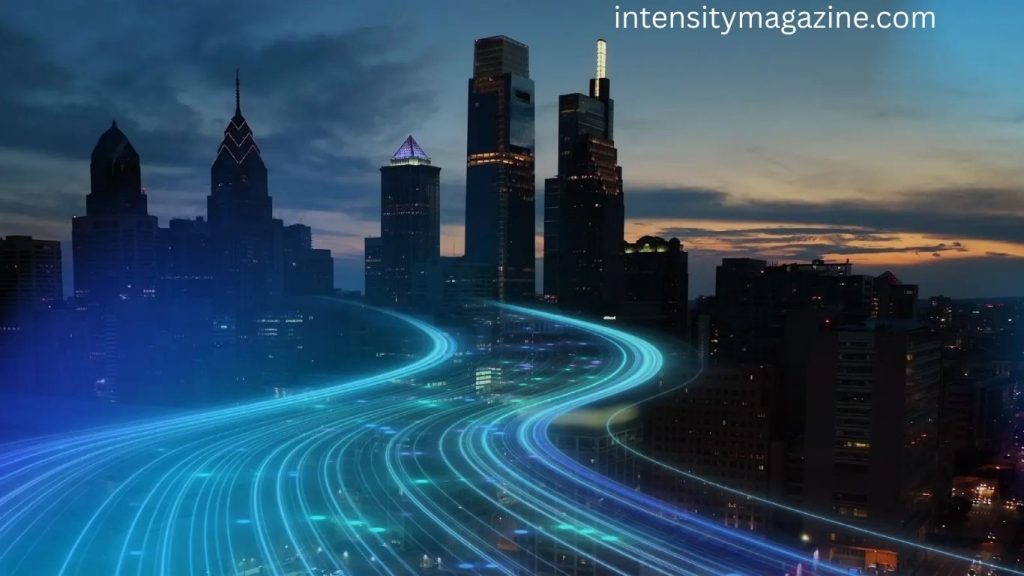Urban life is entering a new chapter. What was once imagined as futuristic “smart cities” is now a reality, powered by the Internet of Things (IoT). Across the globe, cities are embedding sensors, networks, and intelligent systems into their infrastructure to create safer, greener, and more efficient environments. This transformation goes beyond traffic lights or energy grids—it’s reshaping the way we live, work, and interact with our cities.
At the core of this shift is IoT: a web of connected devices that collects and shares real-time data. From resource management to public safety, IoT is the backbone of modern urban innovation. But while the promise of smart cities is inspiring, it also raises critical questions about ethics, privacy, and inclusivity.
In this article, we’ll explore how IoT is fueling the rise of smart cities, the benefits and challenges that come with it, and the vision of future urban life.
The Engine of Smart Cities: IoT in Action
IoT transforms cities into living organisms that “breathe” data. This continuous flow of information allows governments to respond to problems in real time, improving efficiency and reducing waste. Let’s look at the most impactful areas where IoT is already changing urban management.
Intelligent Transportation
Traffic congestion is one of the biggest headaches of modern cities. IoT offers solutions through smart sensors and AI-driven traffic systems. Connected devices monitor vehicle flow, optimize traffic signals, and provide drivers with real-time route suggestions. Public transport systems also benefit, giving commuters live updates on schedules, delays, and even seat availability.
Smart Lighting Systems
Instead of wasting energy with static streetlights, IoT-powered smart lighting adapts to real needs. Sensors adjust brightness based on movement, weather, or specific events, reducing energy costs while improving safety. Cities such as Barcelona and Singapore have already reported significant savings through this approach.
Waste Management
Overflowing bins are not only unpleasant but also costly to manage. IoT-enabled waste collection solves this by using sensors that track container fill levels. Collection routes can then be planned more efficiently, cutting fuel costs and keeping cities cleaner.
Water and Energy Efficiency
Sustainability is at the heart of smart cities. IoT sensors detect leaks, monitor energy consumption, and optimize distribution networks. This not only conserves resources but also helps households and businesses reduce utility costs. In some cities, these systems are already preventing water shortages and blackouts.
How Smart Cities Transform Daily Life
The influence of IoT is not limited to infrastructure. It directly impacts how citizens experience and navigate their cities.
Greater Comfort and Accessibility
Smart navigation apps powered by IoT make moving around the city easier than ever. Citizens can plan routes, avoid traffic jams, and locate services in seconds. Automated waste collection and lighting systems also create cleaner, more welcoming environments.
Safer Communities
IoT is redefining public safety. Smart surveillance, connected alarms, and predictive crime analytics allow authorities to detect incidents early and respond faster. Environmental sensors track air quality and hazards, contributing to healthier living spaces.
Public Health and Well-being
From monitoring pollution to managing parks and recreational areas, smart cities enhance overall well-being. Access to cleaner air, safer water, and intelligently managed green spaces promotes healthier lifestyles.
Public Administration, Governance, and Taxes
Beyond lifestyle changes, IoT has profound implications for governance. Cities can become more transparent, efficient, and responsive.
Smarter Tax Collection and Spending
IoT-driven efficiency reduces costs for services like lighting, waste management, and water supply. Savings can be redirected toward essential services or used to ease the tax burden on citizens. This creates a more equitable system of public finance.
Transparency and Citizen Participation
Real-time data on city management builds trust between citizens and governments. People can monitor resource usage, understand where taxes go, and even participate in decision-making through digital platforms.
Privacy and Security Concerns
The flip side of data-driven governance is the challenge of privacy. With billions of data points collected daily, protecting personal information is critical. Strong cybersecurity policies and transparent regulations are essential for citizens to feel secure in this new era.
Challenges and Opportunities of IoT-Driven Cities
Infrastructure and Interoperability
Building and maintaining a large-scale IoT network requires massive investment. Cities must ensure systems are compatible across platforms and industries to maximize efficiency.
Data Privacy and Cybersecurity
Cyberattacks are a real threat. A breach in IoT systems could compromise public safety or sensitive citizen data. Continuous innovation in cybersecurity is non-negotiable.
Digital Divide and Inclusivity
Smart cities risk leaving behind those without access to digital tools. To avoid deepening inequalities, governments must prioritize digital inclusion through education and affordable access.
Sustainability Opportunities
On the positive side, IoT has unparalleled potential to reduce environmental impact. Smarter use of energy and water, reduced emissions through efficient transport, and better waste management all move cities toward sustainability goals.
The Cities of Tomorrow
The vision of future cities goes beyond efficiency—they will be adaptive ecosystems designed for people.
Intelligent and Sustainable Infrastructure

Tomorrow’s cities will integrate renewable energy, smart buildings, and sustainable waste management. Buildings will generate their own power and support healthier lifestyles with air-quality monitoring and automated climate control.
Citizen-Driven Governance
Digital platforms will allow citizens to have a stronger voice in urban planning. Governments will rely on data-backed policies that directly reflect community needs.
Urban Mobility Reinvented
Autonomous vehicles, shared mobility platforms, and hyper-efficient public transport will redefine urban mobility. Reduced traffic, lower emissions, and increased accessibility will improve life for all citizens.
Facing Future Challenges
Climate change, cybersecurity risks, and social inequality will continue to test cities. Building resilience into systems will be key to ensuring sustainable progress.
Frequently Asked Questions:
What is a smart city?
A smart city uses digital technologies, especially the Internet of Things (IoT), to improve infrastructure, optimize resources, and enhance the quality of urban life.
How does IoT help in building smart cities?
IoT connects devices, sensors, and systems to collect real-time data. This data is used to manage traffic, reduce energy waste, improve safety, and deliver more efficient public services.
What are the main benefits of smart cities?
Smart cities offer cleaner environments, reduced congestion, efficient public services, improved safety, and better citizen engagement through data-driven governance.
Can smart cities improve public safety?
Yes. IoT-powered surveillance, smart lighting, and rapid emergency response systems enhance security and help authorities act quickly in crisis situations.
How do smart cities contribute to sustainability?
They use IoT sensors to manage water, electricity, and waste efficiently, reducing environmental impact and conserving natural resources.
Are there risks to privacy in smart cities?
Yes. Since IoT collects large amounts of data, strong cybersecurity measures and transparent policies are essential to protect citizens’ privacy.
Will smart cities make life more affordable?
Efficient services and optimized resource management can lower operational costs, which may reduce utility bills and even ease the tax burden over time.
Conclusion
The rise of smart cities powered by the Internet of Things marks a defining shift in how we experience urban life. By harnessing real-time data, cities are becoming safer, cleaner, and more efficient, offering solutions to some of the biggest challenges of modern living. From sustainable resource management to smarter governance, IoT-driven innovation is setting the foundation for a brighter, more connected future.



